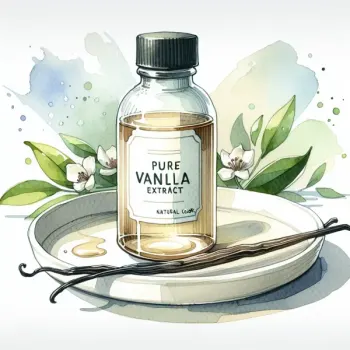
Substitutes for pure vanilla extract include maple syrup, honey, almond extract, vanilla bean paste, vanilla powder, vanilla sugar, and almond extract. These alternatives vary in flavor and are used in beverages, dairy-free, gluten-free, and general dessert recipes, allowing for versatility in cooking and baking.
Maple syrup can be used in a 1:1 ratio to add a sweet, woodsy flavor to beverages. It pairs well with warm drinks and can be an excellent addition to cocktails. Use high-quality, pure maple syrup for the best flavor, such as Pure Canadian or Crown Maple.
Honey can substitute vanilla extract in beverages, providing a natural sweetness and depth of flavor. Start with a small amount and adjust to taste, as honey's flavor is stronger and sweeter. Local and raw honey varieties offer the best flavor profiles.
Almond extract can be used sparingly, typically starting with a few drops and adjusting to taste due to its strong flavor. It works well in coffee and tea, providing a nutty undertone. McCormick and Nielsen-Massey are well-known brands.
Vanilla bean paste is dairy-free and can be used in place of vanilla extract in a 1:1 ratio. It provides a rich, robust flavor and is ideal for those avoiding dairy. Nielsen-Massey and Singing Dog are recommended dairy-free brands.
Maple syrup can replace vanilla extract in dairy-free recipes, offering a unique flavor. Use in a 1:1 ratio, but be aware it will add additional sweetness. Pure Canadian and Crown Maple are high-quality dairy-free options.
Vanilla bean paste is gluten-free and can be used in a 1:1 ratio, offering a rich vanilla flavor with the addition of bean seeds for texture and appearance. Nielsen-Massey and Singing Dog offer gluten-free options.
Vanilla powder is a suitable gluten-free substitute in a 1:1 ratio. It provides a similar flavor profile without moisture, making it great for gluten-free dry mixes. Look for gluten-free brands like Cook's and Nielsen-Massey.
Vanilla bean paste is a direct substitute for vanilla extract, offering the same rich flavor with the addition of vanilla bean seeds. Use a 1:1 ratio. It provides a more intense vanilla flavor and visual appeal with the specks of vanilla seeds. Popular brands include Nielsen-Massey and Singing Dog.
Vanilla powder can replace vanilla extract in a 1:1 ratio. It's made from ground dried vanilla beans and imparts a similar flavor without the alcohol content. Expect a more subtle flavor profile. It's ideal for dry baking mixes and liquid-sensitive recipes. Brands like Cook's and Nielsen-Massey are well-regarded.
Vanilla sugar, made by infusing sugar with vanilla beans, can add vanilla flavor to your recipes. Use it to replace both the sugar and vanilla extract in a recipe, adjusting quantities to taste. It's perfect for sweetening and flavoring beverages or baked goods. Dr. Oetker is a commonly used brand.
Almond extract can provide a nutty flavor that complements recipes calling for vanilla. Use a smaller quantity, typically a 1:4 ratio, as it is more potent than vanilla extract. Keep in mind the flavor profile will change. McCormick and Nielsen-Massey are popular choices.
Maple syrup can be used as a substitute in a 1:1 ratio, offering a distinct but complementary flavor. It adds sweetness along with flavor, which may affect the overall taste of the recipe. It works well in oatmeal, pancakes, and certain baked goods. Brands like Pure Canadian and Crown Maple are recommended.

Your ultimate Recipe Box, Meal Planner, and Cooking Class all in one
| Recipe Category | Substitutes |
|---|---|
| Beverages | Maple Syrup, Honey, Almond Extract |
| Dairy-Free Recipes | Vanilla Bean Paste, Maple Syrup |
| Gluten-Free Recipes | Vanilla Bean Paste, Vanilla Powder |
| Desserts and Baked Goods | Vanilla Bean Paste, Vanilla Powder, Vanilla Sugar, Almond Extract, Maple Syrup |
Whether due to dietary restrictions, availability, or simply a desire to experiment with different flavors, there are several substitutes for pure vanilla extract that can work across a variety of recipes. Each alternative offers unique characteristics, and it's important to consider the flavor profiles and composition of your dish when selecting a substitute.